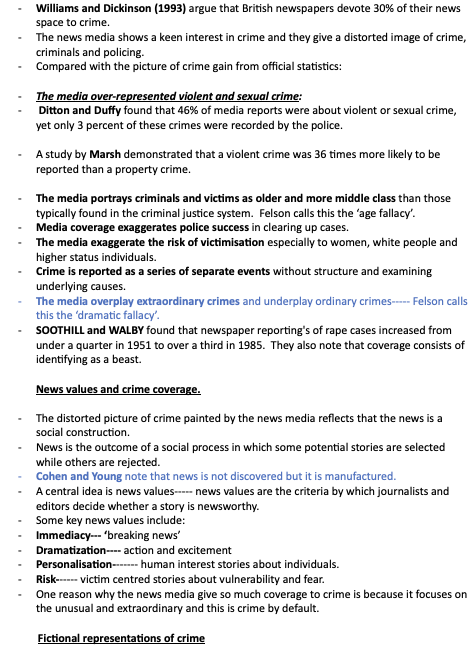Media representations of crime
- Williams and Dickinson (1993) argue that British newspapers devote 30% of their news space to crime.
- The news media shows a keen interest in crime and they give a distorted image of crime, criminals and policing.
- Compared with the picture of crime gain from official statistics:
- The media over-represented violent and sexual crime:
- Ditton and Duffy found that 46% of media reports were about violent or sexual crime, yet only 3 percent of these crimes were recorded by the police.
- A study by Marsh demonstrated that a violent crime was 36 times more likely to be reported than a property crime.
- The media portrays criminals and victims as older and more middle class than those typically found in the criminal justice system. Felson calls this the ‘age fallacy’.
- Media coverage exaggerates police success in clearing up cases.
- The media exaggerate the risk of victimisation especially to women, white people and higher status individuals.
- Crime is reported as a series of separate events without structure and examining underlying causes.
- The media overplay extraordinary crimes and underplay ordinary crimes----- Felson calls this the ‘dramatic fallacy’.
- SOOTHILL and WALBY found that newspaper reporting's of rape cases increased from under a quarter in 1951 to over a third in 1985. They also note that coverage consists of identifying as a beast.
News values and crime coverage.
- The distorted picture of crime painted by the news media reflects that the news is a social construction.
- News is the outcome of a social process in which some potential stories are selected while others are rejected.
- Cohen and Young note that news is not discovered but it is manufactured.
- A central idea is news values----- news values are the criteria by which journalists and editors decide whether a story is newsworthy.
- Some key news values include:
- Immediacy--- ‘breaking news’
- Dramatization---- action and excitement
- Personalisation------- human interest stories about individuals.
- Risk------ victim centred stories about vulnerability and fear.
- One reason why the news media give so much coverage to crime is because it focuses on the unusual and extraordinary and this is crime by default.
Fictional representations of crime
- Fictional representations of crime follow what SURETTE calls the ‘law of opposites’-- these are the opposites of official statistics.
- Fictional cops usually get their man.
- Property crime is underrepresented while violence, drugs and sexual crimes are overrepresented.
- Furthermore, there is an increasing tendency to show police as corrupt and brutal ( and as less successful.
The media as a cause of crime
- Media has been criticised for a long period of time for encouraging criminal behaviour.
- Grand Theft Auto and rap lyrics have been criticised for encouraging violence and criminality.
- They are several ways the media does this….
- Imitation---- providing deviant role models, this results in ‘copycat behaviour’.
- Temptation--- through viewing violent imagery.
- Glamourising offending
- Portraying the police as incompetent
Fear of Crime
- Media exaggerates the amount of violent and unusual crime and therefore they exaggerate the risks of certain groups becoming victims of crime, such as young women and old people. There is worries that the media may be distorting individuals perceptions of crime.
- Some argue that there is a link between media use and fear of crime.
- GEBNER ET AL found that heavy users of TV had higher levels of fear of crime.
- TUMBER found a correlation between media consumption and fear of crime----- greater fear of being a victim and experiencing ‘physical attack’.
- However, the existence of such correlations does not prove them to be right.
The media, relative deprivation and crime
- Left realists argue that mass media helps to increase the sense of relative deprivation (the feeling of being deprived relative to others).
- In media, materialistic goods and lifestyles are displayed.
- This stimulates a sense of relative deprivation and social exclusion which are felt by marginalised groups.
- As Merton argues, pressure to conform to the norm can cause deviant behaviour when the opportunity to achieve legitimately is blocked.
- In this instance, the media are instrumental is setting the norm and thus promoting crime.
Cultural criminology, the media and crime
- Cultural criminology argues that the media turns crime itself into the commodity that people desire.
- Media encourage them to consume crime, in the form of images of crime.
- YOUNG------ sees late modern society as a media saturated society where we are immersed into the ‘mediascape’ which is an ever-expanding tangle of fluid digital images, including images of crime.
- FENWICK------ ‘ crime is packaged and marketed to young people as cool, romantic, exciting and a fashionable cultural symbol’
CYBER CRIME
- JEWKES (2003) the internet provides opportunities to commit ‘conventional crime’ such as fraud and also ‘new crimes using tools’ such as software piracy.
